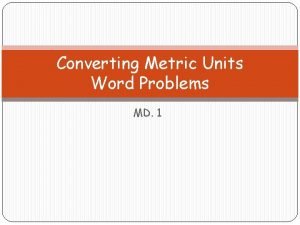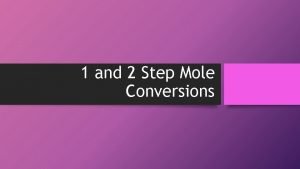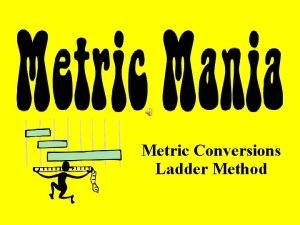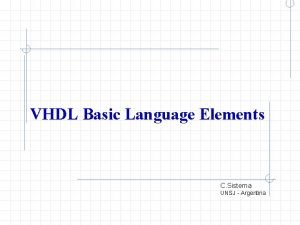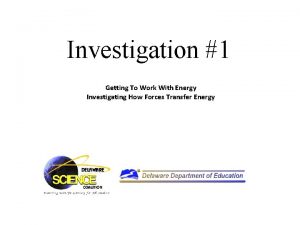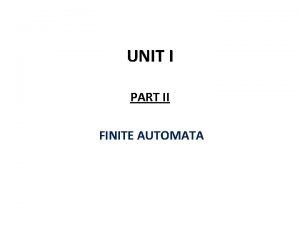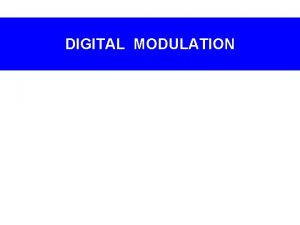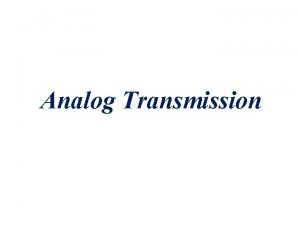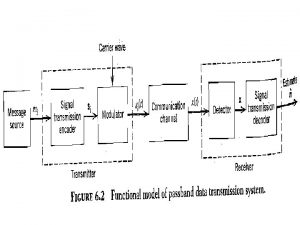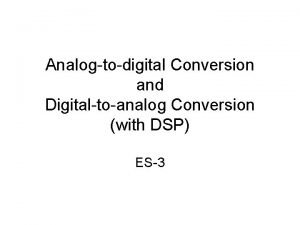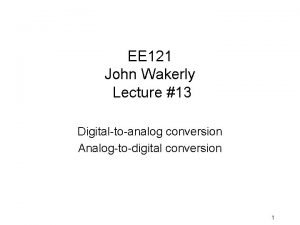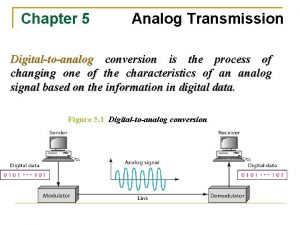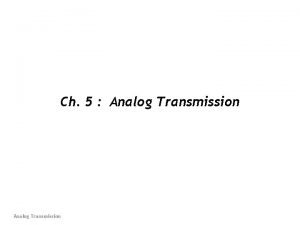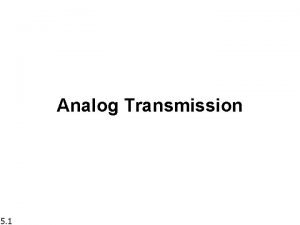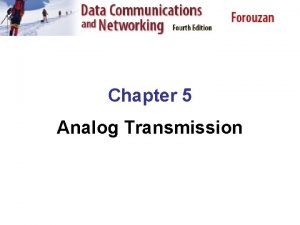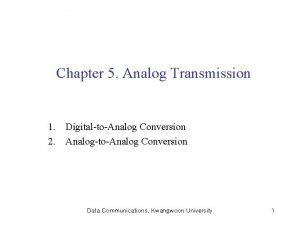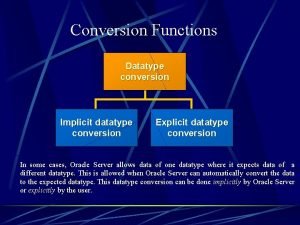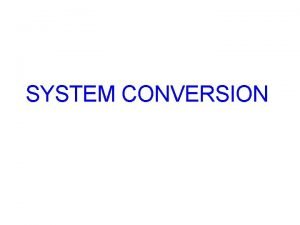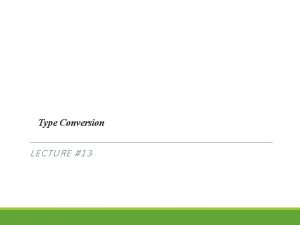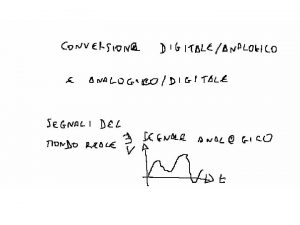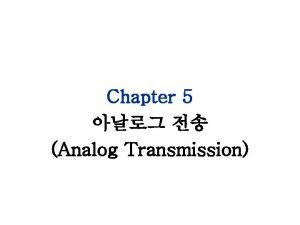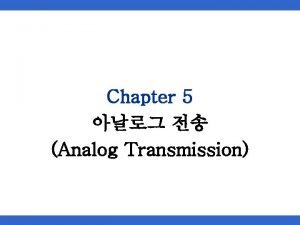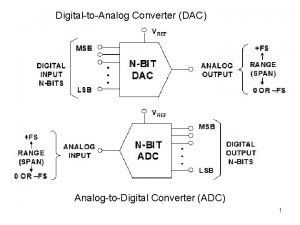5 1 DIGITALTOANALOG CONVERSION Digitaltoanalog conversion is the



















































- Slides: 51

5 -1 DIGITAL-TO-ANALOG CONVERSION Digital-to-analog conversion is the process of changing one of the characteristics of an analog signal based on the information in digital data. Topics discussed in this section: Aspects of Digital-to-Analog Conversion Amplitude Shift Keying Frequency Shift Keying Phase Shift Keying Quadrature Amplitude Modulation 5. 1

Figure 5. 1 Digital-to-analog conversion 5. 2

Figure 5. 2 Types of digital-to-analog conversion 5. 3

Note Bit rate is the number of bits per second. Baud rate is the number of signal elements per second. In the analog transmission of digital data, the baud rate is less than or equal to the bit rate. 5. 4

Example 5. 1 An analog signal carries 4 bits per signal element. If 1000 signal elements are sent per second, find the bit rate. Solution In this case, r = 4, S = 1000 (signal rate, or baud), and N (the bit rate) is unknown. We can find the value of N from 5. 5

Example 5. 2 An analog signal has a bit rate of 8000 bps and a baud rate of 1000 baud. How many data elements are carried by each signal element? How many signal elements do we need? Solution In this example, S = 1000 baud, N = 8000 bps, and r and L are unknown. We find first the value of r and then the value of L. 5. 6

Figure 5. 3 Binary amplitude shift keying How many times does the wave cycle before we can tell a 0 from a 1? Forouzan calls this d which is a constant between 0 and 1. With BASK, d = 1 Note: 1 bit per signal change (r=1) 5. 7

Example 5. 3 In English – with amplitude modulation, signal has to cycle at least twice to interpret as a 1 or 0. So bit rate is often ½ the bandwidth (or bandwidth is 2 x bit rate). 5. 8

Figure 5. 4 Implementation of binary ASK (BASK) 5. 9

Example 5. 3 We have an available bandwidth of 100 k. Hz which spans from 200 to 300 k. Hz. What are the carrier frequency and the bit rate (N) if we modulated our data by using ASK with d = 1? Solution The middle of the bandwidth is located at 250 k. Hz. This means that our carrier frequency can be at fc = 250 k. Hz. We can use the formula for bandwidth to find the bit rate (with d = 1 and r = 1). (next slide) 5. 10

Example 5. 3 Bandwidth = (1+d) x baud rate S Don’t want to know baud rate S, we want to know bit rate N, so substitute S = N x 1/r (from slide 6) Bandwidth = (1+d) x N x 1/r 100 k. Hz = 2 x N x 1/1 100 k. Hz = 2 x N N = 50 kbps 5. 11 (given r=1 and d=1)

Example 5. 4 • In data communications, we normally use fullduplex links with communication in both directions. • We need to divide the bandwidth into two with two carrier frequencies, as shown in Figure 5. 5. • The figure shows the positions of two carrier frequencies and the bandwidths. • The available bandwidth for each direction is now 50 k. Hz, which leaves us with a data rate of 25 kbps in each direction. 5. 12

Figure 5. 5 Bandwidth of full-duplex ASK used in Example 5. 4 5. 13

Figure 5. 6 Binary frequency shift keying (BFSK) d = 1 for BFSK 5. 14

Example 5. 5 We have an available bandwidth of 100 k. Hz which spans from 200 to 300 k. Hz. What should be the carrier frequency and the bit rate if we modulated our data by using FSK with d = 1? Solution This problem is similar to Example 5. 3, but we are modulating by using FSK. The midpoint of the band is at 250 k. Hz. We choose 2Δf to be 50 k. Hz; this means… 5. 15

Example 5. 5 Bandwidth = (1+d) x Baud Rate S + 2Δf Given: 2Δf = 50 k. Hz; d=1; Bandwidth = 100 k. Hz = (1+d) x S + 50 k. Hz = 2 S S = 25 kbaud Data rate N = Baud Rate S x r = 25 kbps 5. 16

Figure 5. 7 Implementation of BFSK 5. 17

Figure 5. 9 Binary phase shift keying (BPSK) d = 0 for PSK 5. 18

Figure 5. 10 Implementation of BPSK 5. 19

QPSK But phase shift keying is more stable than either amplitude shift keying or frequency shift keying. So we can create systems that use more than two phase angles. What about a system that has 4 phase angles? QPSK (Quadrature Phase Shift Keying) Phase shifts occur on the 45, 135, 225, and 315 degrees. 5. 20

QPSK How many bits per signal change? (What is r? ) 5. 21

Example 5. 7 Find the bandwidth for a signal transmitting at 12 Mbps for QPSK. The value of d = 0. Solution For previous example of QPSK, 2 bits is carried by one signal element. This means that r = 2. So the signal rate (baud rate) is S = N × (1/r) = 6 Mbaud. With a value of d = 0, we have B = S = 6 MHz. 5. 22

Figure 5. 12 Concept of a constellation diagram 5. 23

Example 5. 8 Show the constellation diagrams for an ASK, BPSK, and QPSK signals. Solution Figure 5. 13 shows the three constellation diagrams. 5. 24

Figure 5. 13 Three constellation diagrams 5. 25

Note Quadrature amplitude modulation is a combination of ASK and PSK. 5. 26

Figure 5. 14 Constellation diagrams for some QAMs 5. 27

The 4 -QAM and 8 -QAM constellations 5. 28

The 8 -PSK characteristics 5. 29

16 -QAM constellations 5. 30

Bit and baud 5. 31

Table 5. 1 Bit and baud rate comparison Modulation ASK, FSK, 2 -PSK Units Bits/Baud rate Bit Rate Bit 1 N N 4 -PSK, 4 -QAM Dibit 2 N 2 N 8 -PSK, 8 -QAM Tribit 3 N 3 N 16 -QAM Quadbit 4 N 4 N 32 -QAM Pentabit 5 N 5 N 64 -QAM Hexabit 6 N 6 N 128 -QAM Septabit 7 N 7 N 256 -QAM Octabit 8 N 8 N 5. 32

Example A constellation diagram consists of eight equally spaced points on a circle. If the bit rate is 4800 bps, what is the baud rate? Solution The constellation indicates 8 -PSK with the points 45 degrees apart. Since 23 = 8, 3 bits are transmitted with each signal unit. Therefore, the baud rate is 4800 / 3 = 1600 baud 5. 33

Example Compute the bit rate for a 1000 -baud 16 -QAM signal. Solution A 16 -QAM signal has 4 bits per signal unit since log 216 = 4. Thus, (1000)(4) = 4000 bps 5. 34

Example Compute the baud rate for a 72, 000 -bps 64 -QAM signal. Solution A 64 -QAM signal has 6 bits per signal unit since log 2 64 = 6. Thus, 72000 / 6 = 12, 000 baud 5. 35

A telephone line has a bandwidth of almost 2400 Hz for data transmission. 5. 36

Telephone line bandwidth 5. 37

The V. 32 constellation and bandwidth 5. 38

The V. 32 bis constellation and bandwidth 5. 39

5 -2 ANALOG TO ANALOG CONVERSION Analog-to-analog conversion is the representation of analog information by an analog signal. One may ask why we need to modulate an analog signal; it is already analog. Modulation is needed if the medium is bandpass in nature or if only a bandpass channel is available to us. Topics discussed in this section: Amplitude Modulation Frequency Modulation Phase Modulation 5. 40

Figure 5. 15 Types of analog-to-analog modulation 5. 41

Figure 5. 16 Amplitude modulation 5. 42

Note The total bandwidth required for AM can be determined from the bandwidth of the audio signal: BAM = 2 B. 5. 43

Figure 5. 17 AM band allocation 5. 44

Note The total bandwidth required for FM can be determined from the bandwidth of the audio signal: BFM = 2(1 + β)B. 5. 45

Figure 5. 18 Frequency modulation 5. 46

Figure 5. 19 FM band allocation 5. 47

Figure 5. 20 Phase modulation 5. 48

Note The total bandwidth required for PM can be determined from the bandwidth and maximum amplitude of the modulating signal: BPM = 2(1 + β)B. 5. 49

Summary n n 5. 50 Given available bandwidth, what are the carrier frequency and the bit rate if we modulated our data by using ASK with d = 1? (Example 5. 3) We have an available bandwidth of 100 k. Hz which spans from 200 to 300 k. Hz. What should be the carrier frequency and the bit rate if we modulated our data by using FSK with d = 1? (Example 5. 5)

Summary n n 5. 51 Find the bandwidth for a signal transmitting at 12 Mbps for QPSK. The value of d = 0. (Example 5. 7) Be able to create a constellation pattern
 Khi nào hổ mẹ dạy hổ con săn mồi
Khi nào hổ mẹ dạy hổ con săn mồi Cách giải mật thư tọa độ
Cách giải mật thư tọa độ đại từ thay thế
đại từ thay thế Diễn thế sinh thái là
Diễn thế sinh thái là Tư thế worm breton là gì
Tư thế worm breton là gì Vẽ hình chiếu vuông góc của vật thể sau
Vẽ hình chiếu vuông góc của vật thể sau Thế nào là mạng điện lắp đặt kiểu nổi
Thế nào là mạng điện lắp đặt kiểu nổi Lời thề hippocrates
Lời thề hippocrates Các châu lục và đại dương trên thế giới
Các châu lục và đại dương trên thế giới Vẽ hình chiếu đứng bằng cạnh của vật thể
Vẽ hình chiếu đứng bằng cạnh của vật thể Bổ thể
Bổ thể Quá trình desamine hóa có thể tạo ra
Quá trình desamine hóa có thể tạo ra Khi nào hổ mẹ dạy hổ con săn mồi
Khi nào hổ mẹ dạy hổ con săn mồi Làm thế nào để 102-1=99
Làm thế nào để 102-1=99 điện thế nghỉ
điện thế nghỉ Các loại đột biến cấu trúc nhiễm sắc thể
Các loại đột biến cấu trúc nhiễm sắc thể Hát lên người ơi
Hát lên người ơi Thế nào là sự mỏi cơ
Thế nào là sự mỏi cơ Thiếu nhi thế giới liên hoan
Thiếu nhi thế giới liên hoan Fecboak
Fecboak Công thức tính thế năng
Công thức tính thế năng Một số thể thơ truyền thống
Một số thể thơ truyền thống Tỉ lệ cơ thể trẻ em
Tỉ lệ cơ thể trẻ em Hệ hô hấp
Hệ hô hấp Số nguyên tố là gì
Số nguyên tố là gì độ dài liên kết
độ dài liên kết Tư thế ngồi viết
Tư thế ngồi viết Môn thể thao bắt đầu bằng chữ f
Môn thể thao bắt đầu bằng chữ f đặc điểm cơ thể của người tối cổ
đặc điểm cơ thể của người tối cổ Hát kết hợp bộ gõ cơ thể
Hát kết hợp bộ gõ cơ thể Các châu lục và đại dương trên thế giới
Các châu lục và đại dương trên thế giới ưu thế lai là gì
ưu thế lai là gì Thẻ vin
Thẻ vin Trời xanh đây là của chúng ta thể thơ
Trời xanh đây là của chúng ta thể thơ Voi kéo gỗ như thế nào
Voi kéo gỗ như thế nào Cái miệng xinh xinh thế chỉ nói điều hay thôi
Cái miệng xinh xinh thế chỉ nói điều hay thôi Từ ngữ thể hiện lòng nhân hậu
Từ ngữ thể hiện lòng nhân hậu Tư thế ngồi viết
Tư thế ngồi viết Thế nào là hệ số cao nhất
Thế nào là hệ số cao nhất V cc cc
V cc cc Lp html
Lp html Thơ thất ngôn tứ tuyệt đường luật
Thơ thất ngôn tứ tuyệt đường luật Australian height datum conversion
Australian height datum conversion Conversion of units word problems
Conversion of units word problems Molar road map
Molar road map 2 step mole conversions
2 step mole conversions Unit conversion ladder
Unit conversion ladder Chcis
Chcis Vhdl array attributes
Vhdl array attributes Investigation gagglekeierleber the
Investigation gagglekeierleber the Moore machine
Moore machine Ib to atar conversion 2019
Ib to atar conversion 2019











































